Back to Activities
Lesson Plan Using the Virtual Bead Loom
3rd Grade and Above
Teacher: Mimi Thomas
Teacher materials and resources as found at the virtual Bead Loom Website are also used. Look at Jim Barta's Math/Beadwork Activity Suggestions and Linda Rodrigues' Virtual Bead Loom Workbook Chapter
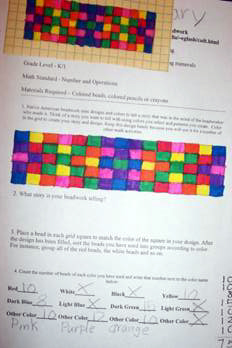
Children were read the “Fly on the Ceiling a Math Myth” which is a story about Rene Descartes by Dr. Julie Glass. We then create on large graph paper ¼ inch squares a four fold symmetry design using colored markers. See left side of example below. That is transferred to the worksheet as seen in the middle to create a 75 bead design in four fold symmetry. The worksheet is being sent to Ron Eglash to scan into and include on the teaching materials section of the web site. Students count up sum for each color as seen on the right. They then add those numbers and should end up with a total of seventy five beads. We talk about area, arrays, perimeter, ratio, and percentages of colors. (see Jim Barta's Activity 1 page)
Use markers (large) to fill in the squares.
Students then bead using the following directions and see the following examples of completed work.
Here are the actual beadings after going through the design process and then beading process. Notice they have two axes of symmetry. These can be created on a stiff plastic paper plate loom. Make 6 slits in each side and warp the paper(plastic )plate . Six strings will be on the front area where one is to bead. Warping the loom in snuggly wrapping yarn around the plate through the slits. String must be pretty tight but not too tight so as to bend the plate. Use big yarn needles and pony beads. I buy box of beads for about $12.00 at Walmart and the needles(2for .79). Plastic ones or metal ones work. The needle must slide easily through the bead. Students pick up beads following design in a left to right order and then bring them under the warp strings (first strings wrapped on loom.) On design below I would pick up a blue bead , a blue bead, a red bead and then two more blue beads.
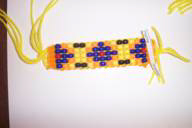
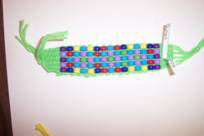

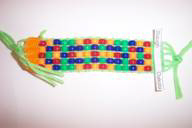
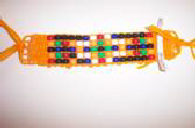
The beads are pushed up from under the warp strings until they pop up through the warp strings, the needle enters from the right side and goes through the beads being sure to keep needle on top of the wrap strings. Just remember the string you are sewing with must be through the bead but on top of the warp strings. Continue one row at a time. I use sticky notes to help students keep their place. At the end of the 15 rows, I have my students weave the remaining yarn to create a binding on each end. When I tie on my string to bead with on the right side I needed to be sure the string is about 2 feet long where it is tied on for a later binding and then enough (4 feet) for attaching beads to the loom and a final binding at the end. Your needle slips onto this string.
We discuss which bead is the point of origin. On this beading it is the black bead. From here they take their design or beading and go to the computer and create their design on the Virtual Bead Loom. They will use all four quadrants. The children did an amazing job with all children finding success from the gifted to the special ed child. The teachers I worked with loved this and plan to incorporate the unit into their math program. This is so nice for the Native American children to see the math connection to their beading. They loved learning to bead and they loved working with the Virtual Bead Loom.
Here are a few of their designs from the virtual Bead Loom:
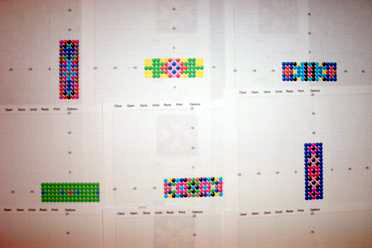
These are fourth and fifth grade students who will now feel very comfortable with the Cartesian Grid when they are introduced to it again later in their schooling.
Assessment of the Project
- Did children take a pretest?
- Did children create a four fold symmetry design showing integrity of work?
- Did children set up their looms correctly?
- Did children bead correctly as taught?
- Did children create a binding at the end?
- Did children create the four fold symmetry on the Virtual Bead Loom using all four quadrants and with their middle bead as the point of origin?
- Did the children find the percent/ratio/fraction of each color of bead? (i.e.Yellow 17%)
- Did children take a post test?
If you have further questions or clarification please email me at mimi.thomas@uintah.net
Mimi Thomas
Teaching Artist for the Art Works For Kids Grant
At Lapoint and Todd Elementary Schools in Uintah School District